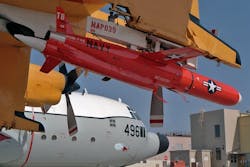Mercury to provide digital radio frequency memory (DRFM) for electronic warfare (EW) on unmanned targets
CHINA LAKE NAVAL AIR WEAPONS STATION, Calif. – U.S. Navy electronic warfare (EW) experts needed digital RF and microwave technology to support the AN/ULQ-21(V) EW jammer. They found their solution from Mercury Systems Inc. in Andover, Mass.
Officials of the Naval Air Warfare Center Weapons Division at China Lake Naval Air Weapons Station near Ridgecrest, Calif., announced a $243.8 million contract to Mercury last week for digital radio frequency memory (DRFM) units and incidental teardown, repair, and upgrades to the AN/ULQ-21(V).
DRFM electronic jammers provide coherent time delay of RF signals in applications like radar and electronic warfare. It also produces coherent deception radar jamming by replaying a captured radar pulse with a small delay, which makes the target appear to move.
DRFM also can modulate captured pulse data in amplitude, frequency, and phase to provide other affects. A Doppler shift correlates range and range rate trackers in the radar. DRFM also can replay captured radar pulses many times to fool the radar into perceiving many targets.
The AN/ULQ-21(V) is a electronic countermeasures system that simulates electronic countermeasures threats. The digital computer-controlled electronic countermeasures system is for use in targets, aircraft external stores, aircraft internal installations, laboratory applications, and land-based instrumentation sites.
The ULQ-21 generates electronic noise, deception, transponder, and a combination electronic countermeasures to enable manned aircraft and unmanned targets to simulate observed and projected electronic countermeasures.
The current ULQ-21 countermeasures has several interchangeable modules for configuration versatility. Experts also are developing miniaturized payloads for small aerial targets such as the BQM-74.
The Navy's AN/ULQ-21 can produce noise and deception techniques across the 850 MHz to 18 GHz frequency range that are either generic or validated high-fidelity simulations of specific foreign electronic attack systems.
Mercury also has developed the modular digital receiver exciter (MoDREx) to help generate electronic attack techniques, ranging from individual emitters to several independently operated emitters. MoDREx emitter filtering separates several emitter signals, while its adaptive technique generation responds to emitter changes.
MoDREx technology features integrated wideband digital; receiver and controller; one to six RF converter modules; one to 12 micro-DRFM modules; integrated wideband digital receiver and controller; emitter characterization and identification; a library of electronic attack techniques; ability to track as many as 12 simultaneous time coincident emitters; and multi-threat signal sorting and routing to assigned RF converter and micro-DRFMs.
On this contract Mercury will do the work in Cypress, Calif., and should be finished by February 2029. This contract supports Small Business Innovation Research Phase III topic N06-036 titled, "Advance Techniques for Digital Radio Frequency Memory" for the Navy.
For more information contact Mercury Systems online at www.mrcy.com, or the Naval Air Warfare Center Weapons Division-China Lake at www.navair.navy.mil/nawcwd.
